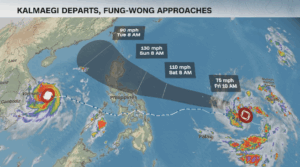HANOI / MANILA — Typhoon Kalmaegi, one of the strongest tropical cyclones to hit Southeast Asia this year, made landfall in central Vietnam late Thursday after leaving a trail of devastation across the central Philippines, where more than 110 people were killed and entire neighborhoods swept away.
The storm — carrying sustained winds of up to 125 miles per hour, according to the U.S. National Oceanic and Atmospheric Administration (NOAA) — inundated vast swathes of the Philippines’ Visayas region earlier in the week before striking Vietnam’s central coast. Philippine authorities confirmed that Kalmaegi (locally known as Tino) destroyed more than 116,000 homes and damaged infrastructure across Cebu, Leyte, and northern Mindanao islands. Officials reported at least 114 fatalities, most from drowning, and tens of thousands left homeless.
Philippines Declares State of Calamity
President Ferdinand Marcos Jr. declared a national state of calamity on Thursday, pledging continued relief and rehabilitation efforts. “Our focus now is on rescue, recovery, and rebuilding communities,” the president said in a televised address.
Rescue teams in Cebu and Talisay waded through waist-deep floodwaters to retrieve survivors and recover bodies from submerged homes. “We don’t have any home anymore. We weren’t able to salvage anything,” said Mely Saberon, a 52-year-old resident of Talisay, speaking to Reuters.
Officials said the typhoon’s slow movement and heavy rainfall — dumping more than a month’s worth of precipitation in just 24 hours — triggered flash floods and landslides. CNN meteorologist Taylor Ward noted that while the public often focuses on wind speed, “water is almost always the No. 1 killer.”
Braces for Impact Amid Record Rainfall
After crossing the South China Sea, Kalmaegi strengthened again before slamming into Vietnam’s Gia Lai province late Thursday. Authorities evacuated more than 350,000 residents from low-lying areas as the storm threatened flash floods and landslides in already waterlogged regions.
The government’s disaster agency reported that last week’s torrential rains had already flooded 116,000 homes and 5,000 hectares of crops, submerging the UNESCO World Heritage town of Hoi An. Power outages and transportation disruptions compounded the crisis.
A Region Under Climate Pressure
International scientists and climate agencies reiterated that global warming is amplifying tropical storms across the western Pacific — the world’s most active cyclone basin. Warmer oceans, fueled by rising greenhouse gas emissions, provide more energy for storms to intensify rapidly and dump unprecedented volumes of rain.
“This is what a climate crisis looks like for the Global South,” said Dr. Nguyen Thi Lan, a climatologist with the Vietnam Academy of Science and Technology. “These communities are paying the price for a problem they did not create.”
A Growing Pattern of Disasters
The Philippines has already faced 20 named storms this year, with Kalmaegi following closely on the heels of Typhoon Ragasa, which struck the region in September. Another system, Tropical Storm Fung-Wong (known locally as Uwan), is expected to strengthen into a Category 3 or 4 cyclone over the weekend, threatening northern Luzon with further flooding and destruction.
As emergency teams in both nations work to restore electricity, clear debris, and provide temporary shelter, humanitarian agencies are warning that intensified storms — coupled with inadequate urban planning and clogged waterways — could make such disasters increasingly deadly in coming years. (hb)

